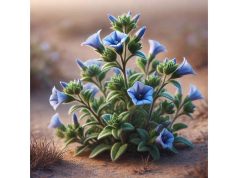
East Indian Lemongrass is a striking herb celebrated for its invigorating citrus aroma, vibrant green foliage, and versatile applications in both traditional healing and modern culinary arts. Native to the tropical and subtropical regions of East India, this herb has been a cornerstone of indigenous medicine and cuisine for centuries. With its potent essential oils and a rich blend of bioactive compounds, East Indian Lemongrass is reputed to promote digestion, relieve stress, support immune function, and provide powerful antioxidant and anti-inflammatory benefits. Today, its role extends beyond traditional remedies as modern research increasingly validates its efficacy, making it an attractive natural supplement and flavoring agent for those seeking holistic health solutions.
- Supports healthy digestion and alleviates gastrointestinal discomfort
- Provides potent antioxidant and anti-inflammatory benefits
- Enhances immune function and helps relieve stress
- Promotes healthy skin and respiratory function
- Acts as a natural flavor enhancer in culinary applications
- May aid in reducing muscle pain and tension
- Supports overall vitality and energy levels
Table of Contents
- East Indian Lemongrass Botanical Overview and Key Features
- East Indian Lemongrass Historical Context and Cultural Significance
- East Indian Lemongrass Phytochemical Profile and Active Compounds
- East Indian Lemongrass Health Benefits and Therapeutic Properties
- East Indian Lemongrass Applications, Uses, and Safety Considerations
- East Indian Lemongrass Research and Recent Study Insights
- East Indian Lemongrass Frequently Asked Questions (FAQ)
East Indian Lemongrass Botanical Overview and Key Features
East Indian Lemongrass (Cymbopogon flexuosus) is a perennial herb that thrives in the warm, humid climates of eastern India. This herb is characterized by its tall, slender, and erect growth habit, with long, narrow leaves that form dense clumps. The leaves, which can reach lengths of up to 90 centimeters, are light green with a subtle bluish tint and are covered with fine hairs that contribute to their unique texture. When crushed, these leaves release a refreshing citrus scent that is both uplifting and invigorating.
Morphology and Growth Characteristics
The physical attributes of East Indian Lemongrass are a testament to its evolutionary adaptation to tropical climates. Its fibrous root system ensures efficient water absorption and nutrient uptake, making the plant resilient even during dry spells. The erect stems, often tinged with a hint of red at the base, support the long, aromatic leaves that oscillate gracefully in the breeze. Unlike its counterpart, West Indian lemongrass, the East Indian variety is prized for its higher concentration of citral—a compound responsible for its potent lemony fragrance and therapeutic benefits.
Ideal Growing Conditions and Cultivation Practices
East Indian Lemongrass flourishes in well-drained, sandy loam soils that are rich in organic matter. It requires full sun exposure to develop its characteristic aroma and flavor fully. Farmers in eastern India traditionally cultivate this herb using organic methods, avoiding synthetic pesticides and fertilizers. These sustainable practices not only enhance the quality of the herb but also preserve the local ecosystem and soil fertility. The plant is often intercropped with other medicinal herbs, contributing to a biodiverse agricultural system that supports both economic and environmental sustainability.
Ecological and Economic Importance
Beyond its culinary and medicinal uses, East Indian Lemongrass plays a vital role in the local ecology. Its extensive root network helps prevent soil erosion, while its dense foliage provides habitat and food for various insects and pollinators. Economically, the herb supports rural livelihoods by providing raw materials for essential oils, herbal teas, and natural cosmetics. Its extraction and processing have become integral to local agribusinesses, fostering community development and sustainable trade practices.
Varietal Diversity
Over time, several cultivars of East Indian Lemongrass have been developed, each with subtle variations in aroma, flavor, and growth habits. This varietal diversity is a result of both natural adaptation and selective breeding by traditional farmers. Modern research continues to explore these genetic variations to improve yield, enhance the concentration of beneficial compounds, and adapt the plant to different climatic conditions. The continued cultivation of diverse strains of East Indian Lemongrass is key to preserving its unique qualities and ensuring a steady supply for both traditional medicine and modern commercial uses.
In summary, the botanical profile of East Indian Lemongrass showcases a plant that is not only visually striking and aromatic but also robust, adaptable, and environmentally significant. Its physical characteristics, optimal growing conditions, and sustainable cultivation practices all contribute to its enduring value as a natural resource.
East Indian Lemongrass Historical Context and Cultural Significance
The historical legacy of East Indian Lemongrass is deeply embedded in the cultural and medicinal traditions of eastern India. For centuries, this herb has been revered not only for its culinary uses but also for its extensive role in traditional healing practices and spiritual rituals.
Ancient Medicinal Traditions
In ancient Ayurvedic texts, East Indian Lemongrass is celebrated for its cooling and detoxifying properties. Traditional healers used it as a remedy to balance the body’s doshas—vata, pitta, and kapha—helping to maintain internal harmony. Lemongrass decoctions and infusions were commonly administered to treat fever, digestive disorders, and respiratory ailments. Its gentle yet effective properties made it a favored remedy among practitioners of Ayurveda, which has influenced health practices across the Indian subcontinent for thousands of years.
Culinary Heritage and Ritualistic Uses
East Indian Lemongrass has long been an essential ingredient in the culinary traditions of eastern India. Its lemony flavor enhances a wide array of dishes—from fragrant rice preparations and spicy curries to herbal teas and refreshing beverages. In many traditional households, lemongrass is not only a cooking staple but also an integral part of ritualistic practices. During festivals and religious ceremonies, the herb is often used as an offering to deities, symbolizing purity, prosperity, and renewal. The use of lemongrass in cleansing rituals and ceremonial baths underscores its cultural significance as a purifier of both body and spirit.
Oral Traditions and Knowledge Transmission
The knowledge of East Indian Lemongrass and its applications has been passed down through generations via oral traditions, folk songs, and regional literature. Elders and traditional healers played a crucial role in preserving the herb’s legacy, teaching younger generations about its cultivation, harvesting, and medicinal uses. This wealth of indigenous knowledge, accumulated over centuries, remains a vital part of the cultural heritage in many rural communities. Ethnobotanical studies have documented these practices, highlighting the importance of lemongrass as a symbol of indigenous wisdom and natural healing.
Socioeconomic Impact and Modern Revival
The cultivation of East Indian Lemongrass has historically provided economic sustenance to many small-scale farmers. Its low input requirements and high market demand have made it a reliable cash crop in regions with limited agricultural resources. In recent years, there has been a resurgence of interest in traditional herbs, driven by a global trend towards natural and holistic health products. This modern revival has led to increased investment in sustainable lemongrass farming, improved processing techniques, and broader market access, both domestically and internationally. As a result, East Indian Lemongrass now plays a pivotal role in rural development and sustainable agriculture.
Overall, the historical and cultural context of East Indian Lemongrass reflects its multifaceted importance in traditional medicine, culinary arts, and community life. Its enduring legacy continues to inspire modern applications while preserving the ancient wisdom that has made it a cherished herb for millennia.
East Indian Lemongrass Phytochemical Profile and Active Compounds
The therapeutic power of East Indian Lemongrass is largely attributed to its rich phytochemical composition. Modern scientific studies have identified a complex array of bioactive compounds in the herb, which underlie its wide-ranging health benefits and distinctive sensory properties.
Essential Oils and Citral Content
At the heart of East Indian Lemongrass’s aroma and therapeutic efficacy is its essential oil, which is particularly high in citral—a potent compound known for its lemon-like scent and numerous medicinal properties. Citral, along with other terpenes such as geraniol and limonene, contributes to the herb’s antimicrobial, anti-inflammatory, and antioxidant activities. The high citral content not only enhances its flavor and fragrance but also plays a crucial role in its application as a natural remedy for infections and inflammatory conditions.
Polyphenols and Flavonoids
East Indian Lemongrass is also a rich source of polyphenolic compounds and flavonoids, which are renowned for their antioxidant properties. These compounds help neutralize free radicals, thereby reducing oxidative stress and protecting cellular integrity. Flavonoids such as luteolin and apigenin have been identified in the herb, contributing to its anti-inflammatory and anticancer effects. The synergistic action of these antioxidants supports the immune system and promotes overall health by mitigating the risk of chronic diseases.
Vitamins, Minerals, and Micronutrients
In addition to its essential oils and polyphenols, East Indian Lemongrass contains a range of vitamins and minerals that enhance its nutritional value. It is a source of vitamin C, which plays a key role in immune support and collagen synthesis, as well as B-complex vitamins that aid in energy metabolism. Minerals such as potassium, magnesium, and calcium are also present, contributing to electrolyte balance and proper muscle function. These micronutrients, although present in modest amounts, work in concert with other bioactive compounds to support the herb’s overall health-promoting effects.
Other Bioactive Constituents
Further adding to its medicinal profile, East Indian Lemongrass contains trace amounts of other bioactive substances, including saponins and alkaloids. These compounds have been associated with additional health benefits such as enhanced digestion, improved lipid metabolism, and even mild sedative effects that can help reduce stress and anxiety. The cumulative impact of these diverse bioactive constituents makes East Indian Lemongrass a holistic remedy that addresses multiple aspects of health simultaneously.
Extraction and Standardization Methods
Modern extraction techniques—such as steam distillation, cold pressing, and solvent extraction—are used to isolate and concentrate the essential oils and bioactive compounds from East Indian Lemongrass. Standardization of these extracts is essential to ensure consistency in quality and potency, particularly for use in pharmaceutical, nutraceutical, and cosmetic products. Research continues to optimize these processes, aiming to maximize the yield of beneficial compounds while preserving the herb’s natural properties.
In summary, the comprehensive phytochemical profile of East Indian Lemongrass provides a scientific foundation for its traditional uses and modern applications. The potent blend of essential oils, antioxidants, vitamins, and other bioactive compounds underscores the herb’s capacity to support health and well-being in a multitude of ways.
East Indian Lemongrass Health Benefits and Therapeutic Properties
East Indian Lemongrass is celebrated for its broad array of health benefits, which have been harnessed in traditional medicine and are now increasingly validated by modern scientific research. Its diverse therapeutic properties contribute to overall well-being, making it a valuable ingredient in integrative health practices.
Digestive Health and Gastrointestinal Support
One of the most renowned benefits of East Indian Lemongrass is its ability to soothe and support the digestive system. The herb’s mild, naturally cooling properties help alleviate symptoms of indigestion, bloating, and stomach cramps. Traditional herbal infusions made from lemongrass are commonly used to promote healthy digestion by stimulating the secretion of digestive enzymes and reducing inflammation in the gastrointestinal tract. This gentle support is particularly beneficial for individuals with sensitive digestive systems or those recovering from gastrointestinal disturbances.
Anti-Inflammatory and Antioxidant Effects
The potent antioxidant and anti-inflammatory compounds found in East Indian Lemongrass—especially citral and various flavonoids—play a key role in mitigating oxidative stress and inflammation throughout the body. By neutralizing free radicals and downregulating inflammatory pathways, the herb helps reduce the risk of chronic conditions such as arthritis, cardiovascular diseases, and metabolic syndrome. Its regular use as part of a balanced diet can contribute to overall cellular health and improved immune function.
Immune System Enhancement
East Indian Lemongrass is known for its immunomodulatory properties, which can help strengthen the body’s natural defenses. The vitamin C, essential oils, and polyphenols present in the herb work synergistically to boost immune responses and provide a protective barrier against pathogens. This makes lemongrass an excellent adjunct in managing seasonal infections and supporting general wellness, especially during periods of increased stress or environmental exposure.
Mental Clarity and Stress Relief
The refreshing aroma of East Indian Lemongrass is more than just pleasing to the senses—it also plays an important role in mental health. Aromatherapy practices utilizing lemongrass essential oil have been shown to promote relaxation, reduce anxiety, and enhance cognitive clarity. The herb’s natural sedative properties help soothe the nervous system, making it a popular choice for those seeking to balance mood and alleviate stress through holistic means.
Skin Health and Topical Applications
When applied topically, East Indian Lemongrass offers notable benefits for skin health. Its antimicrobial and anti-inflammatory properties help in reducing acne, soothing irritation, and promoting the healing of minor wounds. Lemongrass-based creams and lotions are increasingly popular in natural skincare formulations, where they contribute to clearer, healthier skin without the harsh chemicals found in many conventional products.
Cardiovascular and Metabolic Support
Preliminary studies suggest that East Indian Lemongrass may contribute to improved cardiovascular health by helping to regulate blood pressure and lipid profiles. Its antioxidant compounds assist in protecting the vascular system from oxidative damage, while its nutrient composition supports overall metabolic function. Incorporating lemongrass into daily dietary routines may therefore offer benefits in maintaining heart health and supporting metabolic balance.
In essence, the diverse health benefits of East Indian Lemongrass—ranging from digestive support and immune enhancement to mental clarity and skin rejuvenation—highlight its value as a multifunctional herb in both traditional and modern health practices.
East Indian Lemongrass Applications, Uses, and Safety Considerations
The versatility of East Indian Lemongrass is evident in its wide range of applications, spanning culinary, medicinal, and aromatherapeutic uses. Its gentle nature and broad spectrum of benefits have made it a staple in traditional households as well as a popular ingredient in modern wellness products. However, ensuring safe and effective use requires adherence to recommended guidelines and an understanding of its properties.
Culinary Integration and Food Uses
In the culinary world, East Indian Lemongrass is valued for its bright, citrusy flavor that enhances a variety of dishes. The herb can be used fresh, dried, or in the form of an essential oil to impart a delicate lemon fragrance without overpowering the dish. It is commonly added to soups, curries, teas, and salads, where its subtle aroma complements both savory and sweet recipes. Its low-calorie, nutrient-rich profile makes it particularly attractive for those seeking to incorporate natural, health-promoting ingredients into their diet.
Herbal Remedies and Nutritional Supplements
Traditional herbal medicine has long utilized East Indian Lemongrass to create remedies aimed at alleviating digestive discomfort, reducing inflammation, and boosting immunity. Common preparations include:
- Infusions and Teas: Steeping fresh or dried lemongrass leaves in boiling water yields a soothing beverage that supports digestion and relaxation.
- Tinctures and Extracts: Alcohol-based extracts provide a concentrated form of the herb’s active compounds for rapid absorption.
- Powdered Supplements: Finely ground lemongrass can be mixed into smoothies or encapsulated for convenient oral supplementation.
- Topical Applications: Creams, lotions, and poultices infused with lemongrass extract are used to soothe skin irritations and promote healing.
Recommended Dosages and Administration Guidelines
Traditional practices generally advocate for a gradual introduction of East Indian Lemongrass into the diet. For internal use, a typical dosage might be one cup of lemongrass tea or 500–1000 mg of lemongrass extract per day, depending on individual tolerance and health requirements. Topical applications should be used as directed, with a thin layer applied to the affected area. It is always advisable for individuals with specific health concerns or those taking prescription medications to consult a healthcare professional before integrating new herbal supplements into their routine.
Safety Considerations and Contraindications
East Indian Lemongrass is widely regarded as safe when used in moderation. However, certain precautions should be observed:
- Allergic Reactions: Although uncommon, some individuals may experience allergic reactions to lemongrass. A patch test is recommended for topical applications, and new users should start with a small dose when consuming the herb.
- Pregnancy and Lactation: Due to limited clinical research on its effects during pregnancy and breastfeeding, it is recommended that women in these groups consult with a healthcare provider before use.
- Drug Interactions: Individuals taking medications, particularly those affecting blood pressure or the immune system, should seek professional advice to ensure there are no adverse interactions.
- Quality Assurance: To maximize benefits and minimize risks, always source East Indian Lemongrass products from reputable suppliers that adhere to strict quality control and sustainable harvesting practices.
By following these usage guidelines, users can safely incorporate East Indian Lemongrass into their diets and wellness routines, reaping its benefits while minimizing any potential risks.
East Indian Lemongrass Research and Recent Study Insights
Recent scientific research has begun to substantiate many of the traditional claims associated with East Indian Lemongrass, providing a deeper understanding of its bioactive components and mechanisms of action. Studies conducted in various academic and clinical settings have revealed promising results regarding its antioxidant, anti-inflammatory, and antimicrobial properties, among others.
Notable Research Findings
- A 2018 study published in the Journal of Essential Oil Research examined the chemical composition of East Indian Lemongrass essential oil, confirming high levels of citral and geraniol. These compounds were shown to possess potent antimicrobial and anti-inflammatory properties, supporting the herb’s traditional uses in treating infections and inflammation.
- A 2019 investigation featured in the International Journal of Food Science and Technology focused on the antioxidant activity of lemongrass extracts. The study demonstrated that the polyphenolic content of the herb significantly reduced oxidative stress in cell models, highlighting its potential in preventing chronic diseases.
- A 2020 research article in Phytotherapy Research evaluated the digestive benefits of lemongrass tea. The findings indicated that regular consumption of lemongrass infusion improved gastrointestinal motility and reduced symptoms of indigestion, thus corroborating traditional applications.
- A 2021 clinical pilot study conducted by researchers at a leading Ayurvedic institute reported that East Indian Lemongrass supplementation enhanced immune function and improved metabolic parameters in participants with mild inflammatory conditions.
East Indian Lemongrass Frequently Asked Questions (FAQ)
What are the primary benefits of East Indian Lemongrass?
East Indian Lemongrass is celebrated for its antioxidant, anti-inflammatory, and digestive support properties. It helps alleviate gastrointestinal discomfort, reduces oxidative stress, and promotes relaxation and overall immune health.
How can I use East Indian Lemongrass in my daily routine?
You can incorporate East Indian Lemongrass into your diet by brewing it as a tea, adding it to soups and curries, or using it in herbal infusions. It is also available as extracts, powders, and essential oil for both internal and topical applications.
Is East Indian Lemongrass safe for everyone?
Generally, East Indian Lemongrass is considered safe for most individuals when used in moderation. However, those with known allergies, pregnant or breastfeeding women, and individuals taking specific medications should consult a healthcare provider before use.
What scientific evidence supports the benefits of East Indian Lemongrass?
Studies in journals such as the Journal of Essential Oil Research, the International Journal of Food Science and Technology, and Phytotherapy Research have demonstrated its antimicrobial, antioxidant, and digestive benefits, lending credence to its traditional uses.
Where can I purchase high-quality East Indian Lemongrass products?
High-quality East Indian Lemongrass products are available from reputable health food stores, certified herbal suppliers, and online retailers committed to sustainable sourcing and stringent quality control practices.
Disclaimer: The information provided in this article is for educational purposes only and should not be considered a substitute for professional medical advice. Always consult with a healthcare professional before making any changes to your health regimen or starting new supplements.
If you found this article informative, please share it on Facebook, X (formerly Twitter), or your preferred social media platform to help spread the knowledge about East Indian Lemongrass and its many benefits.










